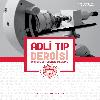Adli otopsilerde tüberküloz kaynaklı ölüm olguları ışığında otopside biyo-güvenlik
Tuberculosis-related deaths in forensic autopsies and biosafety considerations
___
- 1.Kadayıfçı A, Karaaslan Y, ed. İç Hastalıkları. Hekimler yayın birliği, 1998: 146-155.
- 2.World Health Organisation, Treatment of tuberculosis, guidelines for national programmes. WHO report, Genova, 1993.
- 3.Maartens G. New developments in adult tuberculosis. Pulmonary Medicine 2002; 8(3): 173-177.
- 4.McKinney J. In vivo Veritas: the search for TB drug targets goes live. Nature Med 2000; 6: 1330-33.
- 5.Saldana MJ. Pathology of Pulmonary Disease. J.B.Lippincott Co 1994:451-463.
- 6.Kurt BN, Taylor DG, Jonathan YR. Biosafety considerations for autopsy. The Am J Forensic Med Pathol 2002; 23(2): 107-122.
- 7.Wilkins D, Woolcock AJ, Cossart YE. Tuberculosis: medical students at risk. Med J Aust 1994; 160(7): 395-7.
- 8.Grist NR, Emslie JA. Association of Clinical Pathologists' surveys of infection in British clinical laboratories, 1970-1989. J Clin Pathol 1994;47:391-4.
- 9.Teppo L, Ojajarvi J, Brander E. The tuberculosis morbidity among pathologists in Finland. Scand J Resp Dis 1974; 55: 257-61.
- 10.Kent JH. The epidemiology of multidrug-resistant tuberculosis in the United States. Med Clin North Am 1993; 77: 1391-1409.
- 11.Ellner JJ. Tuberculosis. In: kelley WN, ed. Textbook of Internal Medicine. New York, Lippincott publications; 1989: 1569-1577.
- 12.Segal-Maurer S, Urban C, Rahal JJ.et al. Current perspectives on multidrug-resistant bacteria. Infect Dis Clin of N Am 1996; 10: 939-957.
- 13.Cantwell MF, Snider DE, Cauthen GM, et al. Epidemiology of tuberculosis in the United States, 1985 through 1 992. JAMA 1994; 272: 535-539.
- 14.Collins CH, Grange JM. Tuberculosis acquired in laboratories and necropsy rooms. Commun Dis Public Health 1999; 2(3):161-7.
- 15.Grist NR, emslie J. Infections in British clinical laboratoriesz 1982-83. J Clin Pathol 1985; 38: 721-5.
- 16.O'Brain DS. Patterns of occupational hand injury in pathology: the interaction of blades, needles and the dissector's digits. Arch Pathol Lab Med 1991; 115: 610-3.
- 17.Hutchins KD, Williams AW, Natarajan GA. Neck needle foreign bodies: an added risk for autopsy pathologists. Arch Pathol Lab Med 2001; 125:790-2.
- 18.Weston J, Locker G. Frequency of glove puncture in the Postmortem room. J Clin Pathol 1992; 45: 177-8.
- 19.Hawkey PM, Pedler SJ, Southall PJ. Streptococcus pypgenes: a forgotten occupational hazard in the mortuary. BMJ 1980; 281: 1058.
- 20.Goette DK, Jacobson KW, Doty RD. Primary inoculation tuberculosis of the skin (prosectors paronychia). Arch Dermatol 1978; 114: 567-9.
- 21.Collins CH; Kennedy DA. Microbiological hazards of occupational needlestick and "sharp" injuries. J Appl Bacteriol 1987; 62: 385-402.
- 22.Weilbaecher Jr JO, Moss ES. Tularemia following injury while performing post-mortem examination on human case. J Lab Clin Med 1938;24:34-8.
- 23.West DJ. The risk of hepatitis B infection among health professionals in the United States: a review. Am J Med Sci 1984; 287: 26-33.
- 24.Harrington JM, Oakes D. Mortality study of British pathologists 1974-80. Br Industrial Med 1984; 41: 188-91.
- 25.Coleman DL, Luce JM, Wilber JC, et al. Antibody to the retrovirus associated with the AIDS. Arch Intern Med 1986; 146: 713-5.
- 26.Ball J, Desselberger U, Whitewell H. Long-lasting viability of HIV after patient's death. Lancet 1991; 338: 63.
- 27.Douceron H, Deforges L, Sobel A, Gherardi RK. HIV-2 cultured from blood 16 days after death. Lancet 1993; 341: 1342-3.
- 28.Meade GM. Prevention of primary tuberculosis infections in medical students: the autopsy as source of primary infection. Am Rev Tuberc 1948; 58: 675-83.
- 29.Morris SI. Tuberculosis as an occupational hazard during medical training. Am Rev Tuberc Pulm Dis 1946; 54: 140-58.
- 30.Gren FHY, Yoshida K. Characteristics of aerosols generated during autopsy procedures and their potantial role as carriers of infectious agents. Appl Occup Environ Hyg 1990; 5: 853-8.
- 31.Johnson GK, Robinson WS. Human immundefficiency virus-1 in the vapors of surgical power instruments. J Med Virol 1991; 33: 47-50.
- 32.Templeton GL, llling LA, Young L, Cave D, Stead WW, et al. The risk for transmission of mycobacterium tuberculosis at the bedside and during autopsy. Ann Intern Med 1995; 122: 922-5.
- 33.Sugita M, Tsutsumi Y, Suchi M, Kasuga H, Ishiko T. Pulmonary tuberculosis: an occupational hazard for pathologists and pathology technicians in Japan. Acta Pathol Jpn 1990; 40: 116-27.
- 34.Liilebaek T, Kok-Jensen A, Viskum K. Bacillarity at autopsy in pulmonary tuberculosis. Mycobacterium tuberculosis is often disseminated. APMIS 2002; 110(9): 625-9.
- 35.Centers for Diesease Control and Prevention, National Institutes of Health. Biosafety in microbiological and biomedical laboratories, 4th ed. Washington, DC: US Department of Health and Human Services, US Goverment Printing Office, 1999.
- ISSN: 1018-5275
- Başlangıç: 1985
- Yayıncı: BAYT Yayıncılık
Bursa'da otopsisi yapılan karbonmonoksit zehirlenmesine bağlı ölümler
Mehmet Sunay YAVUZ, Nilgün ŞENOL, Aşkın GÖRGÜLÜ, Tamer KARAASLAN, Serdar Baki ALBAYRAK
Hüdaverdi KÜÇÜKER, Hüseyin FİDAN
Adli otopsilerde tüberküloz kaynaklı ölüm olguları ışığında otopside biyo-güvenlik
İbrahim ÜZÜN, Ömer MÜSLÜMANOĞLU, Yalçın BÜYÜK
Aile bireylerinin adli otopsiye yaklaşımı (Bir anket çalışması)
Nursel TÜRKMEN, Recep FEDAKAR, Dilek DURAK
Bir otopsi olgusunda karaciğerin izole polikistik hastalığı ve multipl safra kanalı mikrohamartomu
Arzu TURAN, Gülşen ÖZBAY, Ferah KARAYEL, Özhan YILMAZER, Elif Ü. AKYILDIZ, Işıl PAKİŞ
Konya ilinde çalışan acil servis hekimlerinin adli raporlara yaklaşımı: Bir anket çalışması
İshak Gürsel GÜNAYDIN, Kamil Hakan DOĞAN, Yusuf AYNACI, Şerafettin DEMİRCİ
